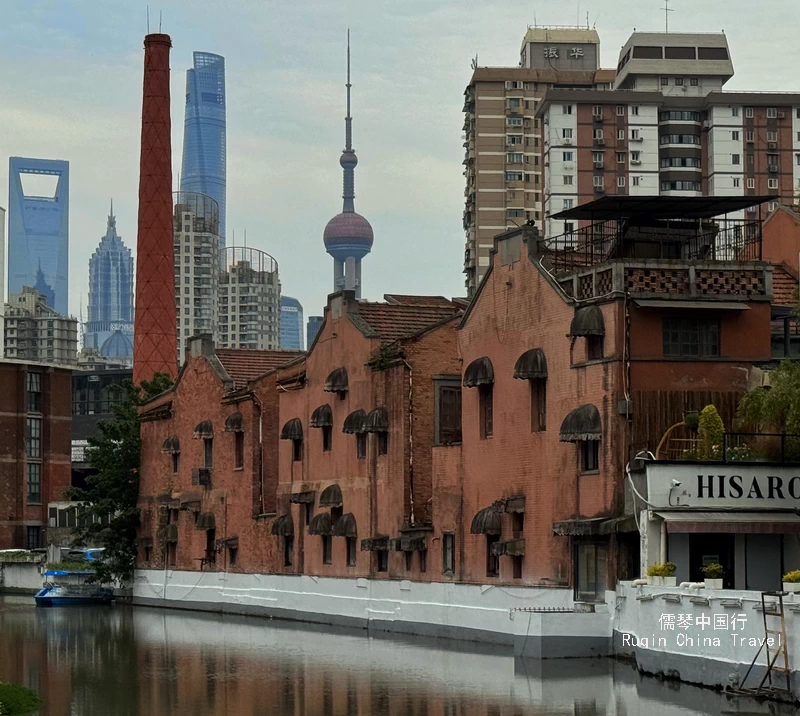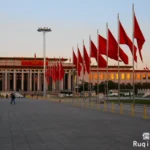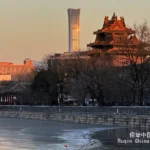When we think of Shanghai, our minds often go straight to the gleaming Oriental Pearl Tower or the historic grandeur of the Bund. But beyond these iconic landmarks, this vibrant city holds secrets—hidden corners steeped in history and character.
One of these lesser-known treasures is 1933 Old Millfun (上海1933老场坊). Tucked away in the Hongkou District, it formerly served as the Shanghai Municipal Council Slaughterhouse, which was the city’s largest facility of its kind at the time. This striking complex invites us into a different side of Shanghai—one far from the tourist crowds.
1. A Walk Into the Past: The Architecture of 1933 Old Millfun
As we approached the main entrance of 1933 Old Millfun, something instantly caught our eye. The perforated cement lattice windows, designed in a basilica style, stood out boldly against the concrete façade. This ancient Roman-inspired design is rare in Shanghai—and we had never seen anything like it before.
Unfortunately, we didn’t bring a wide-angle camera. So, we had to settle for a few close-up shots with our phones. Still, the building’s massive presence came through. The entire outer wall features these detailed hollowed-out patterns. According to locals, all the cement was imported from Britain in the 1930s. No wonder it has stood the test of time—it’s rock solid.
1) Lattice Windows 花格窗 : The Masters of Light and Shadow
These windows weren’t just for decoration. First, their open design helped air flow freely—a must in a place once used for slaughter. Additionally, the windows face west, matching Shanghai’s prevailing winds to improve ventilation.

Interestingly, the west-facing direction also holds a symbolic meaning. In Buddhist beliefs, the West points toward paradise—a peaceful wish for the animals’ rebirth.
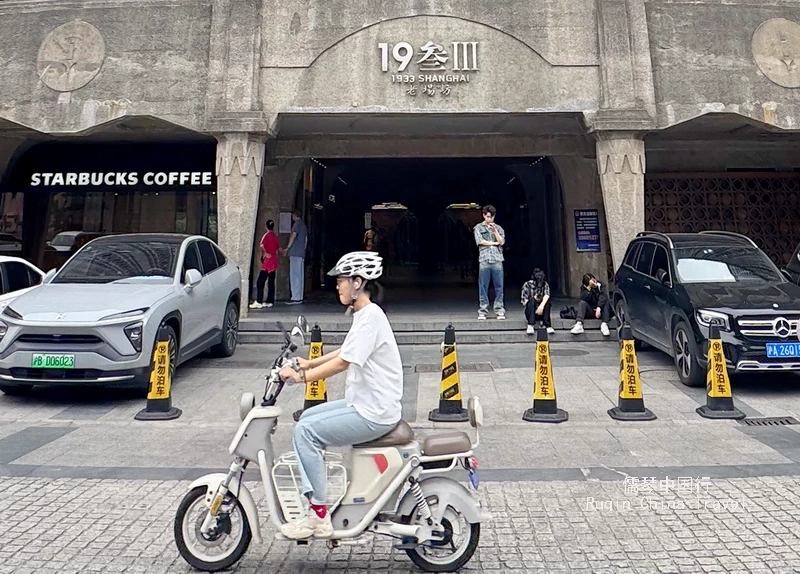
Throughout the day, sunlight filters through these windows, casting ever-changing patterns inside. Photographers love this. Try taking photos at different hours—you’ll capture a completely different mood each time.
2)The Core of the Beast: The Five-Story Central Tower 中心园
Once we stepped into the entrance hall, we saw the starbucks on the left side the lobby.
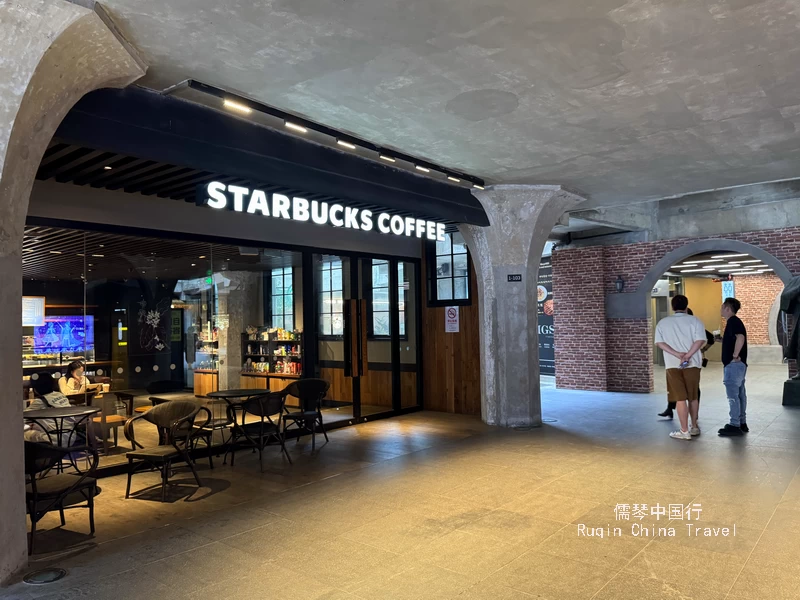
Then, turning left, we began walking around the building’s heart.This main structure is known as the “Central Circle” (中心园)—or more technically, the 24-sided polygonal tower. Though it looks round from a distance, it actually has 24 edges. The tower rises five stories tall, towering over the surrounding space.
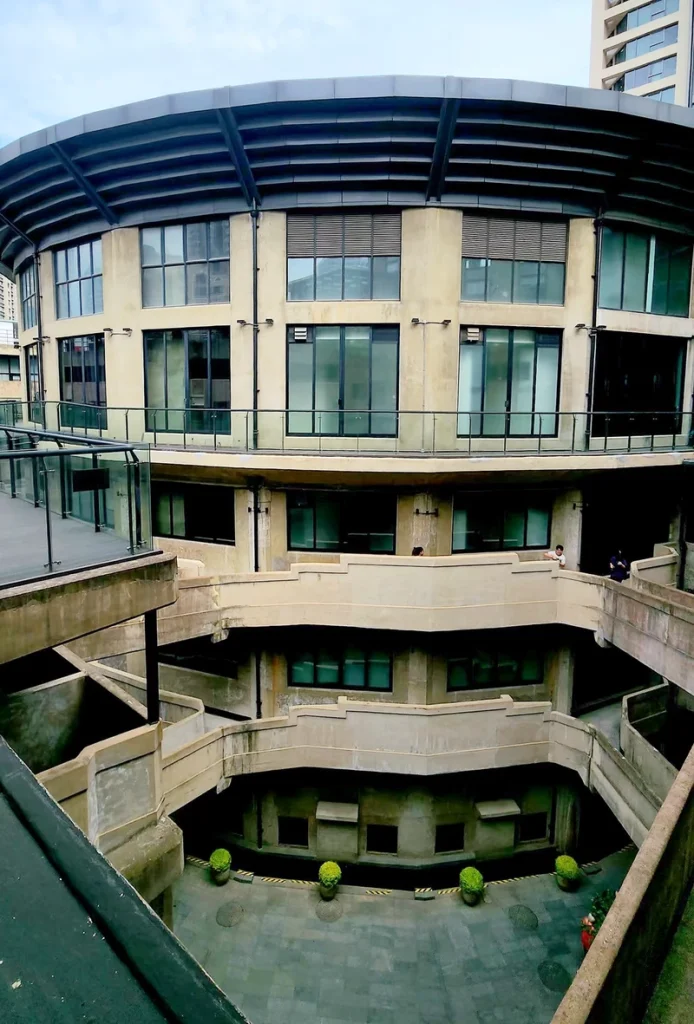
The first to third floors of the Central Circle were originally used as slaughter workshops,connecting to the surrounding outer buildings via corridor bridges and large-curved French spiral staircases.
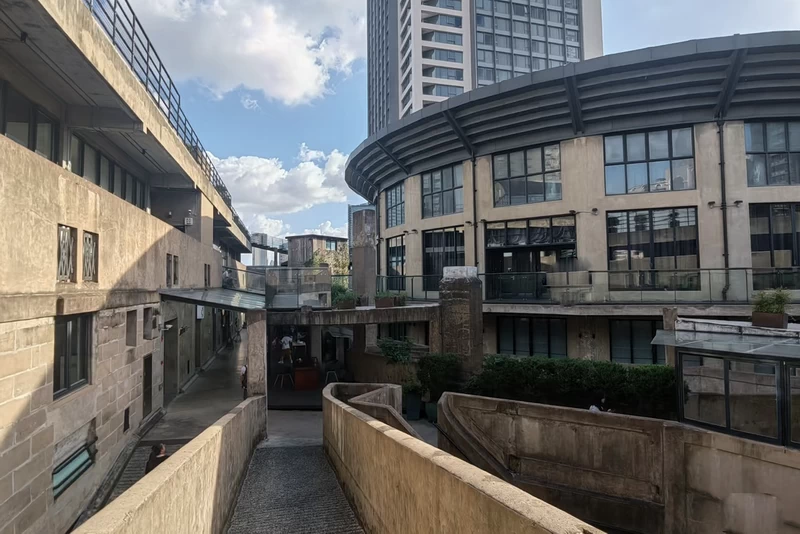
Moreover, its rounded design wasn’t just for aesthetics. It helped streamline movement and operations inside the facility. Workers and animals could flow smoothly from one section to another.
Today, the space feels more like an eerie, concrete temple than a slaughterhouse. The silence echoes off the thick walls. As we looked up at the spiraling walkways and mysterious shadows, we couldn’t help but feel the weight of history.
3) Outer Blocks: The Four Guardians of the Central Tower 外围四栋方形建筑
Surrounding the central round tower, we found four square buildings—one on each side: east, south, west, and north. Together, they formed a large, closed square that wrapped around the circular core. This layout immediately caught our attention.
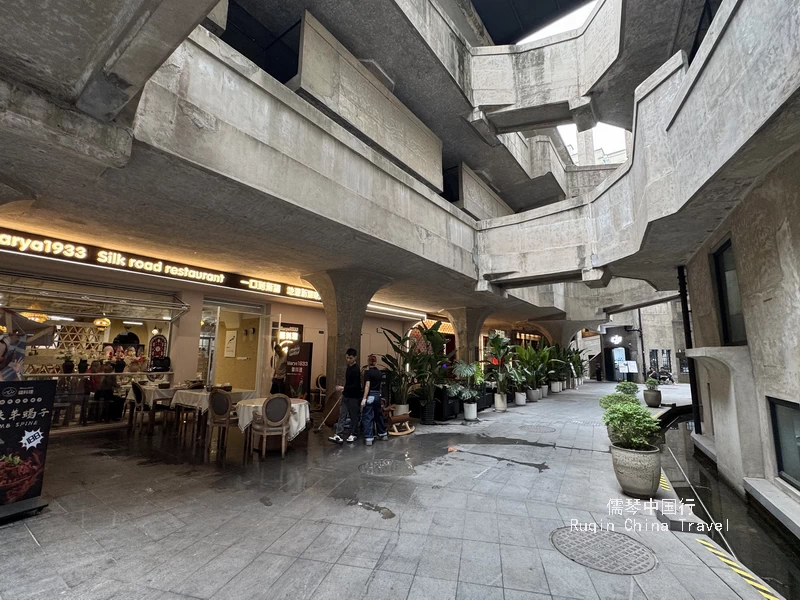
Each of these blocks had a special purpose. They were once used for sorting animals, temporary holding, and support work. Additionally, each block connected to the central tower through corridors of varying widths. These clever pathways (廊桥) ensured humans and animals moved separately, which was a smart—and surprisingly humane—design for its time.
Next, we noticed the scale of the structure. All five buildings—the central circle and the four outer ones—are five stories high. The walls are made from reinforced concrete. Inside, ceiling heights range between 3.2 and 5.8 meters. The place feels both massive and maze-like.
Interestingly, the layout reflects a deeper meaning. The outer square and inner circle follow the Chinese “heaven is round, earth is square” philosophy. At the same time, it blends modern Western industrial planning.
In short, this place is where Chinese tradition and Western engineering meet in concrete form. And we couldn’t stop marveling at it.
4) The Umbrella Columns 伞形柱: Holding Up History with Style
As we continued walking around the central tower, something striking caught our eyes—the umbrella-shaped columns. These massive columns stood proudly around the outer square buildings, quietly holding up the entire structure.
We learned that the whole complex rests on more than 300 of these umbrella columns. Spread evenly throughout the square-shaped outer blocks, they support the heavy concrete frame without needing interior walls. This makes the space feel open and surprisingly airy.
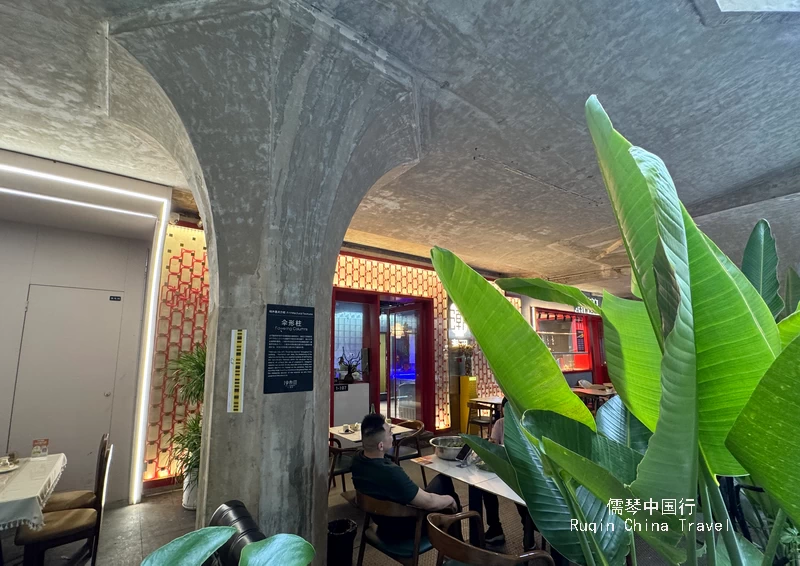
Next, we looked up at the column tops. Some had octagonal caps, mostly on the west side. Others had square-shaped caps, found on the remaining sides. Each one had its own character, and the closer we looked, the more details we noticed.
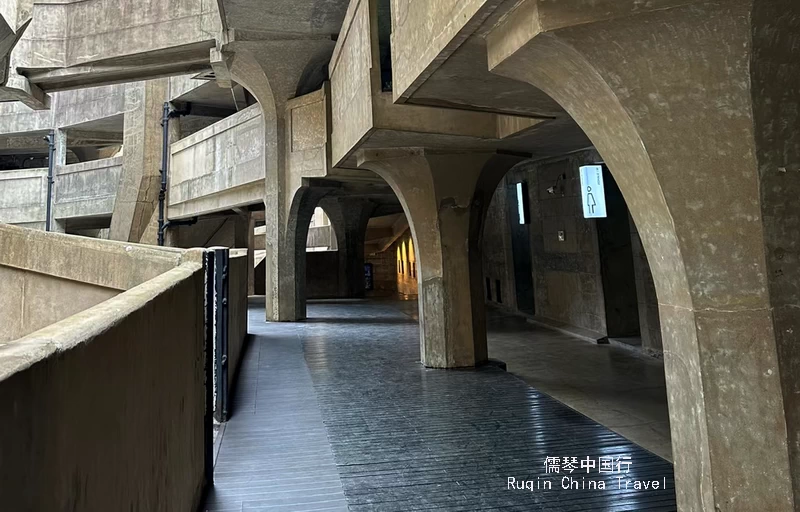
In fact, these columns aren’t just functional—they’re artistic. Their subtle patterns and sculpted edges show clear signs of Art Deco influence. Additionally, no two look exactly the same. Some have floral curves; others display bold geometric lines.
These umbrella columns are more than supports. They are sculptural pillars of design and engineering. They give the entire building a timeless strength—while adding a touch of elegance to all that concrete.
5) The Cattle Ramp 牛道: A Path Through Time
After circling the first floor clockwise, we found a sloping path on the left. It wasn’t an ordinary ramp—it was the cattle passage, known locally as the niudao. Naturally, we followed it upward to the second floor.
At first glance, the path looked rough and worn. However, its design had a clear purpose. About two meters wide, the ramp featured special anti-slip textures, making it safer for the cattle to walk on. As we slowly climbed, we imagined what it must have looked like 70 years ago—livestock moving calmly up the same incline.
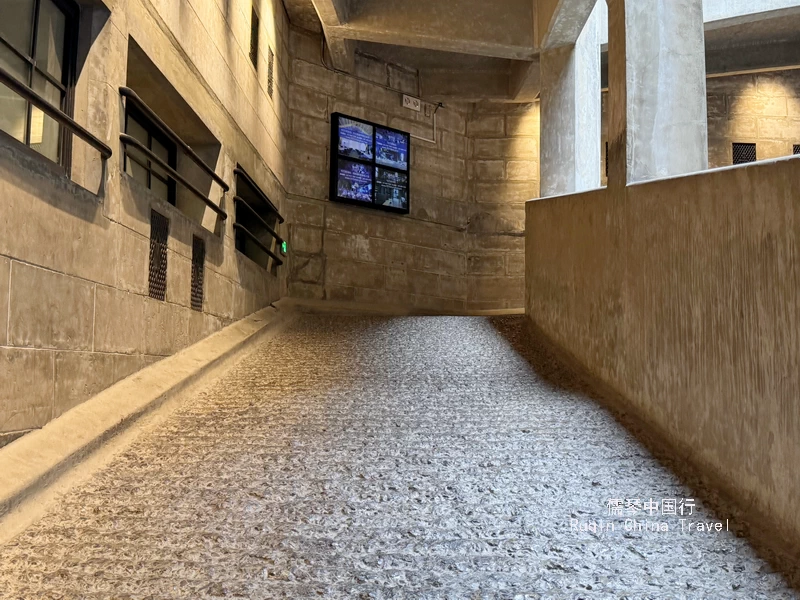
This cattle ramp is one of 1933 Old Millfun’s most unique features. At the time, its slaughter process followed international standards. More importantly, it implemented a system of human-animal separation, which was rare for that era in China.
Today, the ramp still remains. It stands as a powerful symbol of the building’s industrial past, connecting us directly to its once-busy operations.
6) The Outer Walkways 外廊桥: A Maze of Bridges in the Sky
After reaching the second floor, we stepped onto one of the outer walkways. From there, we began strolling clockwise around the complex. Instantly, we felt like we had entered a concrete labyrinth.
These walkways are one of 1933 Old Millfun’s most iconic features. Each bridge links the central tower to the surrounding square buildings. Together, they create a layered web of paths—twisting, turning, and crossing over each other.

In total, the system includes four levels of walkways and 26 slanted bridges. Interestingly, each bridge has a different width. Originally, this was to allow cattle of various sizes to pass through with ease.
Today, the walkways are a dream for photographers and explorers alike. Light pours in through the lattice windows, casting shifting patterns on the rough concrete. With every step, we discovered new angles, hidden corners, and perfect frames.
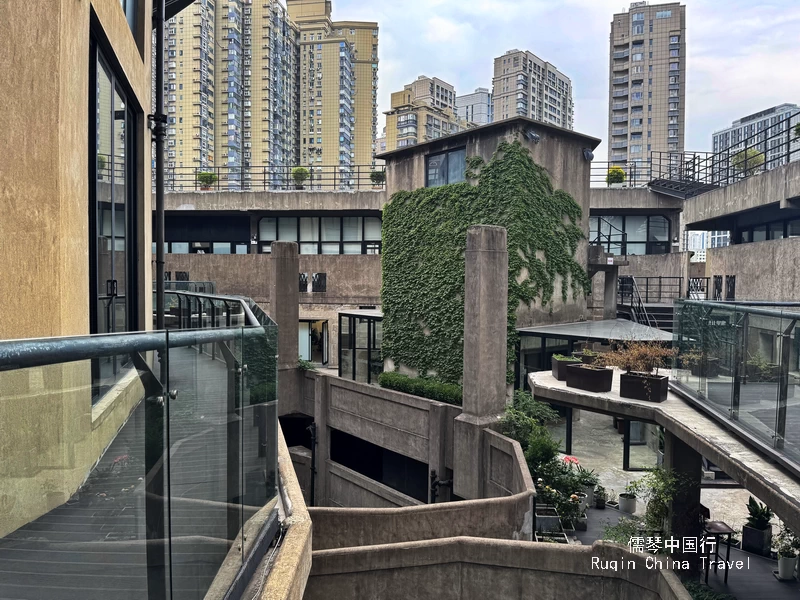
Additionally, these bridges now guide visitors through the complex. They offer ever-changing views of the structure—sometimes open and airy, sometimes tight and mysterious. We couldn’t stop walking. Every turn felt like a new scene in a black-and-white film.
7) The French Spiral Staircase 法式旋梯: An Elegant Escape Route
While cattle used the wide, sloped ramps, workers moved between floors using a narrow French spiral staircase. Just wide enough for one person, the staircase curves gracefully through the air, wrapping around with a wide, dramatic angle.
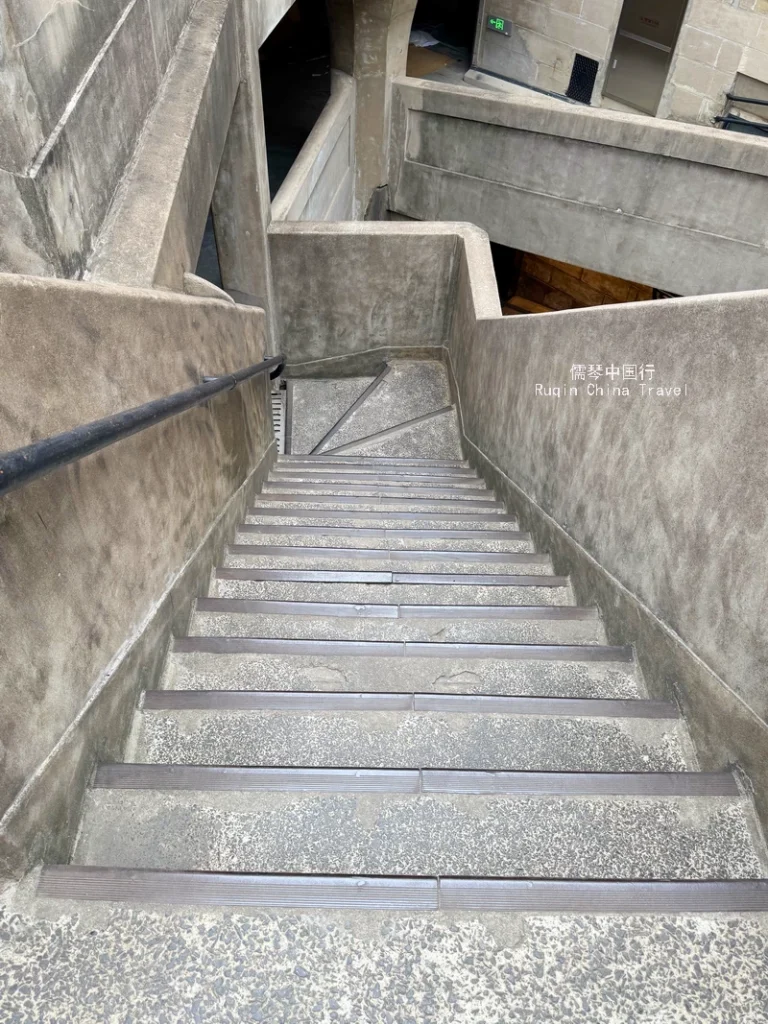
At first, the design looks purely elegant. However, we soon learned the large turning radius served a practical—and urgent—purpose. Back when this was an active slaughterhouse, the central tower was the site of animal processing. Naturally, animals often panicked upon arrival.
To prevent injuries to workers, the architects added these spiraling staircases as emergency escape routes. Their wide turns allowed people to descend quickly and safely, away from frightened animals below.
As we walked the steps today, it felt calm and quiet. But imagining the urgency this space once held gave it a strange, cinematic tension.
2. From Slaughterhouse to Art Sanctuary: A Stunning Transformation
1933 Old Millfun isn’t just a relic—it’s a masterpiece of transformation. Once a place of industrial function, it has now become one of Shanghai’s most vibrant creative hubs. Its structure blends both East and West. The square exterior and circular center reflect China’s ancient “heaven-round, earth-square” belief. At the same time, the clean lines and symmetry echo Western Art Deco style.
Today, the former slaughterhouse has been reborn. It now hosts art exhibitions, fashion shows, immersive theater, film shoots, and trendy restaurants. Additionally, it holds titles like Shanghai’s Outstanding Historic Building and a National Industrial Tourism Demonstration Site.
1) Central Tower (Main Building)
Once the heart of the slaughtering process, the central tower is now a space for creative events. It regularly hosts art shows, brand launches, and performance art.
One of the highlights is its sky stage—a floating platform with a fully transparent glass floor, perfect for high-end events.
2) The Four Outer Buildings
These once held livestock for sorting and storage. Today, they house creative studios, cafés, art galleries, and even music schools. Each building connects to the center via bridges, just like in the past.
3) The Walkway Network
The original 26 sloped bridges are still here. Once built for cows of different sizes, these walkways are now iconic photo spots.
Some remain in use, while others now serve as viewing platforms. Light and shadow play across them all day, creating endless moments of beauty for every visitor.
3. Food & Shopping at 1933 Old Millfun: Where Taste Meets Style
Exploring the winding corridors and sky bridges of 1933 Old Millfun can easily work up an appetite. Fortunately, this architectural maze offers more than visual delights. It’s also a great place to eat, relax, and shop. Whether you’re in the mood for a quiet coffee, a full meal, or a unique souvenir, there’s something for every taste and budget.
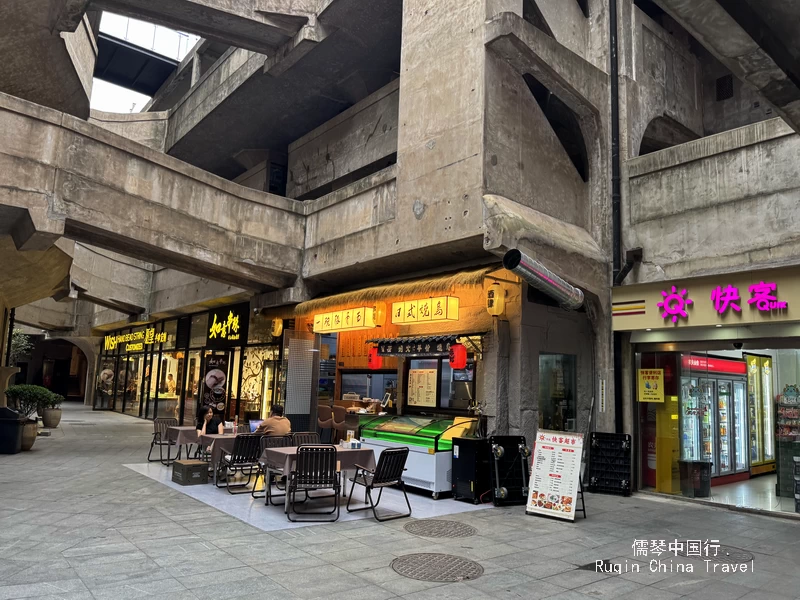
Dining Options Inside 1933 Old Millfun
1) Hongchang Russian Restaurant
First, for something different, head to this elegant spot with authentic Russian charm. The interiors are richly decorated, and the menu includes classics like borscht and grilled meats. It’s a great place to experience another culture without leaving Shanghai.
2) Western-Style Cafés
Next, if you’re looking for a break, try one of the cozy cafés inside the complex. Most offer solid coffee and light bites. Prices are reasonable—around 28–40 RMB per person. We especially recommend the cafés near the rooftop garden, where the view and quiet setting make it a perfect resting spot.
3) Dessert Shops
Further along your walk, you’ll find charming dessert shops with beautifully decorated interiors. Many feature retro or vintage themes, perfect for Instagram shots. Try their cakes and drinks—they’re both delicious and photogenic.
4) Traditional Chinese Vegetarian Restaurant
Just outside the complex sits a serene Buddhist-inspired vegetarian eatery. It’s steeped in tradition. Dishes arrive wrapped in blue floral cloth, and the menu is handwritten on bound rice paper. Every detail reflects classic Chinese culture.
Travel Tip:
Most restaurants get busier in the afternoon. To avoid long waits, consider making a reservation or visiting before the lunch rush.
4. Opening Hours & Best Time to Visit
When planning a trip to 1933 Old Millfun, timing matters. While the building itself stays open around the clock, your experience can vary greatly depending on when you go.
Open Year-Round, Day and Night
The good news is that 1933 Old Millfun is open all year, with no official closing days. The building itself is accessible 24 hours a day, and entrance is completely free. You can wander through its walkways and admire the architecture anytime.
However, not everything stays open 24/7. Shops, restaurants, and exhibitions follow their own hours. Most businesses open around 9:00 AM, but many don’t get fully running until 10:00 AM. Some boutique shops and galleries may not open until the afternoon.
A Word of Caution
Technically, you can visit late at night—but we strongly recommend avoiding the site after 11:00 PM. By then, most stores and cafés will be closed, and the lighting becomes extremely limited. The atmosphere can turn a bit eerie, and navigation isn’t easy.
For the best experience, plan your visit during daylight. That way, you’ll enjoy both the historic beauty and the lively creative vibe that make this place so special.
5. How to Get to 1933 Old Millfun: Your Transport Guide
Getting to 1933 Old Millfun is simple and convenient, especially if you’re exploring central Shanghai. The complex sits in Hongkou District, right at the corner of Liyang Road and Shajing Road, near the former Hongkou Port.
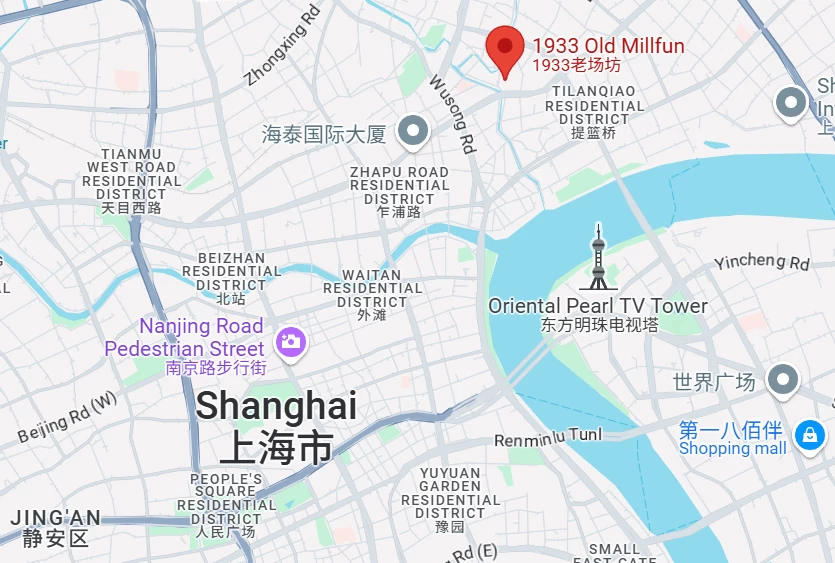
By Metro: The Easiest Way
First, the metro is your best option. Take Line 4 or Line 10 and get off at Hailun Road Station. Then, use Exit 3 to leave the station.
Next, head right (south) along Siping Road (四平路). Then turn left enter Xinjia Road (新嘉路 )and Liaoning Road (辽宁路). Keep walking straight and turn right to enter Shajing Road (沙泾路). After that, you’ll see the massive concrete structure of 1933 Old Millfun appear ahead of you. The entire walk takes about 10 to 12 minutes at a relaxed pace.
If you’re using a taxi or ride-hailing app like Didi, just enter “1933老场坊” or “1933 Old Millfun” into the destination field. Most drivers will recognize it instantly.
1933 Old Millfun Address: 611 Liyang Road, Hongkou District, Shanghai 虹口区溧阳路611号
6. Industrial Relics Meet Modern Shanghai: A Walk Through Time in Hongkou
On our way from Hailun Road Station (Exit 3) to 1933 Old Millfun, we passed by another fascinating spot: Triangle Art Park (三角地艺术园) at 260 Jiaxing Road (嘉兴路260号).

This protected historic building, constructed in 1919, has stood for over a century. Its elegant exterior reflects the area’s early 20th-century charm.
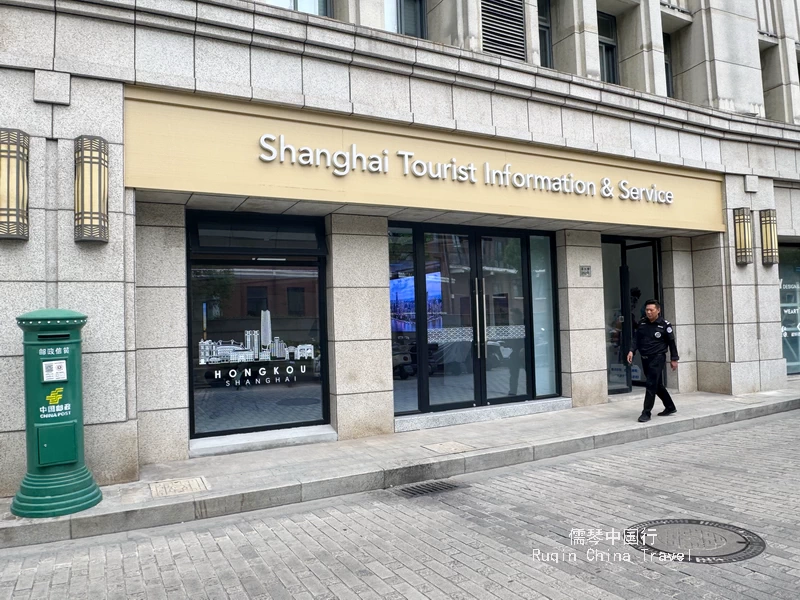
On the ground floor, we found the Shanghai Tourism Information Center—a great place to pick up maps, tips, or just take a short break.
Then we stumbled upon a striking scene. A tall, weathered smokestack stood boldly in front of the glimmering skyscrapers of Lujiazui—including the Shanghai Tower and the World Financial Center. Naturally, we pulled out our phones and captured the moment. It’s a perfect snapshot of old meets new.
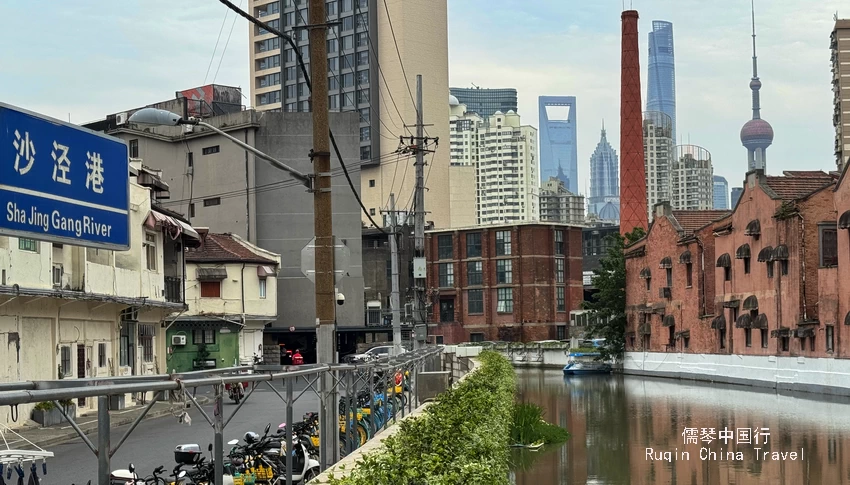
Curious, we looked it up later. This smokestack belongs to the former boiler house of the 1933 slaughterhouse complex. Located at 29 Shajing Road, it sits just across the street from the main 1933 building.
Built in 1935, two years after the main complex, the facility once supplied hot water and steam for the slaughterhouse. This ensured a sanitary and efficient process. The structure features Baroque-style details, echoing the industrial design of the main building while adding its own architectural flair.
This short stroll through Hongkou gave us more than just a walk—it offered a living collage of history, creativity, and modern Shanghai energy. Whether you’re snapping photos or simply soaking in the contrasts, this area is a true reminder that the city’s past still shapes its vibrant present.
1933 Old Millfun is more than just a hidden corner of Shanghai—it’s a living story carved in concrete. Here, industrial past meets creative present, and every stairway, corridor, and shadowed bridge holds a secret waiting to be discovered.
Whether you’re an architecture lover, a history buff, a photographer, or just a curious traveler, this unique space offers something you won’t find anywhere else. So next time you’re in Shanghai, take a detour from the usual path—and step into a time machine that’s still very much alive.

